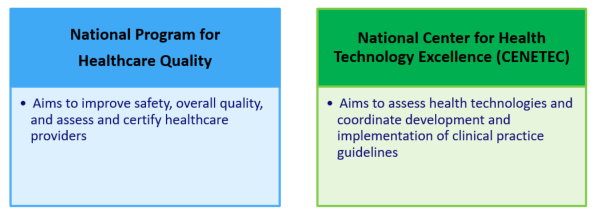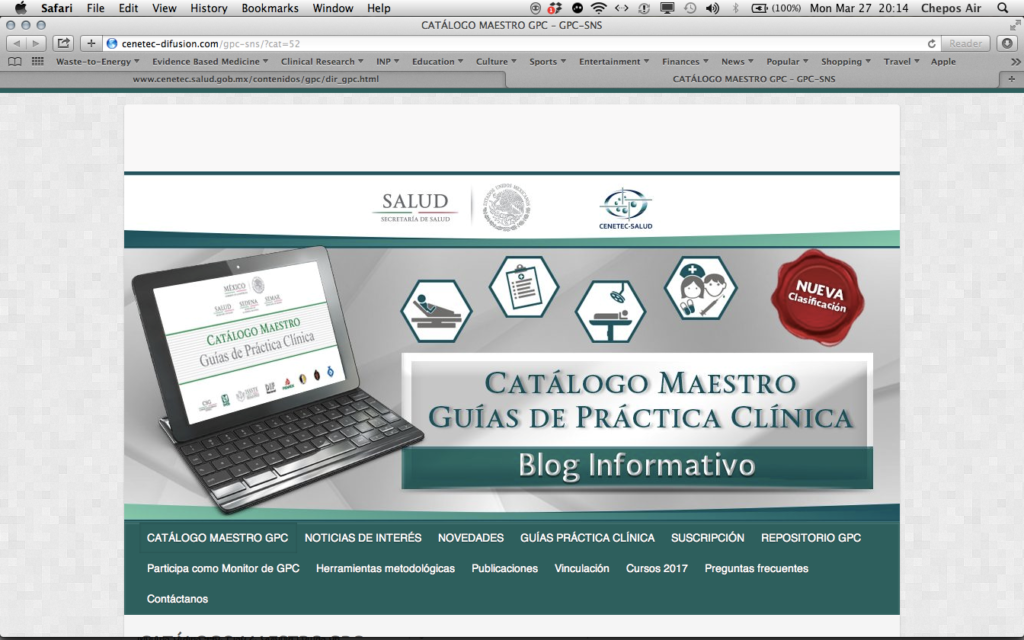
By José Luis Mayorga Butrón, MD, MSc
Otolaryngology Department of the National Institute of Pediatrics, Mexico
Introduction
The functioning of health systems has been a major concern for governments and non-governmental organizations worldwide. Health systems are extraordinarily complex and constantly evolving. Measuring the performance of health systems of any country is a very difficult task and it requires a validated and explicit instrument with clearly defined objectives and outcomes.1
The clinical decision-making process is not an easy task either. Many variables must be taken into account, and most of the time, physicians and patients don't have enough information that has been systematically generated. It is very common that physicians consult with their peers or textbooks, both of which may have some risk of bias in their clinical recommendations.2-4
"The world belongs to the discontented.” Oscar Wilde
Restructuring
Mexican public health organizations endured a major restructuring in the last decade. More than half of the country’s population lacked health services.5 High rates of mortality due to communicable diseases and reproductive health problems associated with the poorest population sector were an issue due to the lack of access to basic medical services.5 In light of these findings, the Mexican government put in place many programs to enhance universal coverage of high priority health conditions. The main objectives of these changes in the national health reorganization were improving stewardship, financing, and service delivery through monitoring, performance evaluation, and regulation of the entire health system.5
Quality improvement initiatives within and across healthcare institutions are crucial to these efforts. One of the cornerstone programs of this reform process included a National Program for Healthcare Quality, which aims to improve safety, overall quality, and assess and certify healthcare providers. The other cornerstone program was the creation of the National Center for Health Technology Excellence (CENETEC) that aims to assess health technologies and coordinate development and implementation of clinical practice guidelines (CPGs).5 Since then, the clinical practice guidelines department has worked with several public institutions to develop and implement CPGs according to the most important healthcare needs in Mexico. Although that program has delivered a large number of documents to support clinical decision making, there is still room for improvement regarding compliance with international standards and implementation of the national program.6
Cornerstone Programs:

In recent years, the interest for CPGs from academic settings and medical societies has increased. This increased interest from different trenches has resulted in collaborative efforts led by CENETEC and specific medical societies. These efforts have brought new challenges, considered by some leaders of the clinical guideline movement as insurmountable, while others report positive experiences. When broad types of entities commit to development of clinical guidelines, issues may arise regarding agreement on methodology, standards for management conflict of interest, timetables, coherence of stakeholder groups, and implementation strategies. Regardless of these challenges and potential issues, clinical guideline leaders in Mexico agreed on the value of multi-stakeholder collaboration as a strategy to improve quality and more efficiently use resources.7-9

National Repository of Clinical Practice Guidelines CENETEC. (http://cenetec-difusion.com/gpc-sns/?cat=52)
The current focus is on forming synergistic relationships to collaborate on developing and implementing trustworthy clinical guidelines with a high likelihood of successful adherence from users. These include:

Clinical guidelines are becoming an increasingly common feature of the healthcare environment around the world, and Mexico is not an exception.7,9
Clinical guidelines will close the gap between science and decision-making in daily practice when all healthcare participants contribute to their development and, most importantly, implementation. This should result in a better quality of healthcare.7
Integration
It is important to point out the importance of the Guidelines International Network (G-I-N), specifically the North America group, as the promoter of integrative efforts among the guideline community in the region, coordinating academic summits, webinars, and collaborative groups. The participation of representatives from Mexico on these activities will enhance expertise and strategies to be applied in the near future.At the end of this year, the National Center for Health and Technology Excellence in collaboration with the Postgraduate Unit, Faculty of Medicine, National University of Mexico is hosting an international forum to be held at the National University in partnership with G-I-N North America. The main objective is to promote deep discussion about a broad range of topics to enhance participation from different sectors of the community improving evidence-based decision-making. CENETEC is expecting participation from medical societies, academia, patient organizations, and medical faculties.
". . . If there is a way for the world to be transformed for the better, it can only be done by pessimism; optimists will never change the world for the better." José Saramago
About the author:
Dr. Mayorga graduated with honors at National University of Mexico (UNAM) in 1999 and completed his residency in Otolaryngology-HNS at National Medical Center in 2004. Dr. Mayorga was member of the Executive Board of the Mexican Society of Otolaryngology-HNS and was the coordinator of the first workshop of EBM. He is one of the founders and Chair of the Evidence Based Medicine and Clinical Practice Guidelines Committee of the Mexican Society of Otolaryngology-HNS. He has published the scientific reports on multi national Clinical Practice Guidelines for Management of Acute and Chronic Rhinosinusitis and for Management of Acute Tonsillitis and Adenoids Hypertrophy for the Pan American Association of Otolaryngology-HNS. He coordinates a multi-stakeholder collaboration regarding adaptation projects in Mexico for Allergic Rhinitis, Asthma and Sinusitis. Dr. Mayorga is currently an associate professor for Clinical Practice Guidelines development and implementation in the master in science program of the Postgraduate Department, Faculty of Medicine of the National University and is member of the Steering Committee of the Guidelines International Network North America based in the NYAM.
References:
References
- World Health Statistics 2016: Monitoring health for the SDGs. World Health Organization. Accessed March 2017, http://www.who.int/gho/publications/world_health_statistics/2016/en/
- Hunink MM, Weinstein MC, Wittenberg E, et al. Decision Making in Health and Medicine: Integrating Evidence and Values. Cambridge University Press, 2001.
- Bate L, Hutchinson A, Underhill J, Maskrey N. How clinical decisions are made. Br J Clin Pharmacol. 2012;74(4):614-20.
- Higgs J, Jones M, Loftus S, Christensen N. Clinical Reasoning in the Health Professions, 3rd ed. Amsterdam: Elsevier-Butterworth-Heinemann; 2008.
- Frenk J, González-Pier E, Gómez-Dantés O, et al. Comprehensive reform to improve health system performance in Mexico. Lancet. 368(9546):1524–1534.
- Knaul FM, González-Pier E, Gómez-Dantés O, et al. The quest for universal Health coverage: achieving social protection for all in Mexico. Lancet. 2012;380:1259-1279
- Mayorga-Butrón JL, Velasco-Hidalgo L, Ochoa-Carrillo FJ. Guías de Práctica Clínica Basadas en Evidencia, cerrando la brecha entre el conocimiento científico y la toma de decisiones clínicas. Documento de la serie MBE, 3 de 3 [Evidence Based Clinical Practice Guidelines, to bridge the gap between science and clinical decision-making. EBM series 3 of 3]. Gaceta Mexicana de Oncología. 2015;14(06):329-334.
- González-Garay A, Mayorga-Butrón JL, Ochoa-Carrillo FJ. Revisiones sistemáticas de la literatura, la piedra angular de la medicina basada en evidencia. Documento de la serie Medicina basada en evidencia, 2 de 3 [Systematic literature reviews: The cornerstone of evidence-based medicine. Evidence-based medicine Series, 2nd of 3]. Gaceta Mexicana de Oncología. 2015;14(02):103-106.
- Montaño-Velázquez BB, Figueroa-Morales MA, Fernández-Celorio A, Ochoa-Carrillo FJ. Fundamentos de la Medicina Basada en Evidencias (MBE). Documento de la serie MBE, 1 de 3 [Fundamentals of Evidence-Based Medicine (EBM). EBM Series - 1st of 3]. Gaceta Mexicana de Oncología. 2014;13(05):274-277.